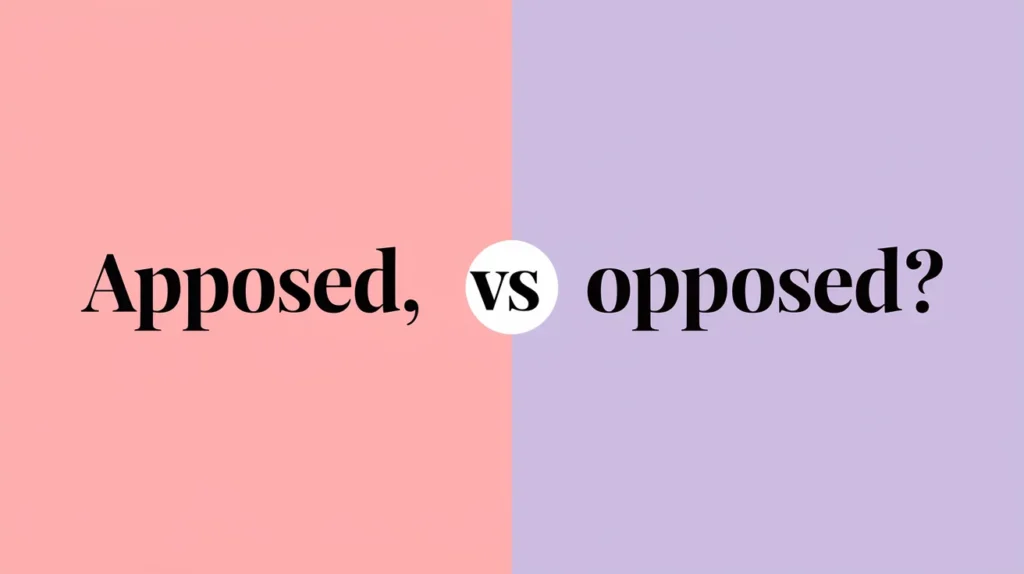In the vast world of the English language, words often sound alike but carry very different meanings. One such pair that can easily confuse even seasoned language enthusiasts is apposed and opposed. These two terms, despite their similar sounds, have entirely distinct meanings and are used in different contexts.
In this article, we will take a deep dive into the meanings, uses, and nuances of apposed and opposed, so you can confidently understand when and how to use each word. We will also explore common mistakes, historical origins, and examples in various contexts to ensure you get a complete understanding of these words.
The Fundamental Difference Between “Apposed” and “Opposed”
At their core, the two words differ in meaning and application. To put it simply:
- Apposed refers to things that are placed next to each other, often in a physical sense. The key idea here is proximity or alignment.
- Opposed refers to resistance, contrast, or a stance taken against something, either in a physical sense or in a more abstract, ideological one.
While apposed is relatively rare and specific to certain fields, opposed is far more commonly used and can be found in everyday conversation and writing.
Meaning and Usage of “Apposed”
Apposed is a formal term primarily used in scientific, biological, and technical contexts. It comes from the Latin word “appositus,” meaning “placed next to” or “set in place.” Essentially, it refers to things that are positioned next to each other, either in a physical or a spatial sense.
Some examples of where apposed is used:
- In Biology/Anatomy: Apposed is used to describe two things that are placed next to each other. For example, two leaves or cells might be described as being apposed if they are placed next to one another in a structure.
Example: “The apposed surfaces of the two leaves enable them to catch sunlight efficiently.” - In Technical or Engineering Contexts: Apposed is used to describe components that are next to each other in a machine or device.
Example: “The apposed gears work together to transfer motion from one part of the machine to another.”
While this word can appear in other contexts, it is most often seen in highly technical or academic discussions.
Meaning and Usage of “Opposed”
On the other hand, opposed is a much more versatile term. It comes from the Latin “opponere,” meaning “to place against” or “to set in opposition.” It is used in a broader range of contexts, from physical opposition to abstract disagreements or ideological stances.
Some examples of where opposed is used:
- In Personal or Political Disagreements: Opposed is frequently used to describe individuals or groups who are in disagreement or conflict with one another.
Example: “He is opposed to the government’s new policy on taxes.” - In Physical Opposition: Opposed can describe physical opposition where two objects or forces are in direct contrast or resistance to each other.
Example: “The two walls are opposed to each other, creating a structural barrier.” - In Ideological or Conceptual Terms: Opposed is also used to describe opposing views, beliefs, or ideologies.
Example: “She was opposed to the idea of changing the traditional curriculum.”
Contexts in Which Each Word Is Used
To truly grasp the difference, let’s break down when you should use each word, depending on the situation.
When to Use “Apposed”
Use apposed when you are describing things that are physically positioned next to or against each other, often in a scientific, technical, or anatomical context.
- Scientific Contexts: “The apposed membranes of the cells were studied under the microscope.”
- Anatomical Contexts: “In the human body, the two bones are apposed in a way that allows for minimal friction.”
- Technical Writing: “The apposed panels created a seamless design for the device.”
When to Use “Opposed”
Use opposed when referring to resistance, opposition, or contrast in any form—whether it’s physical, ideological, or conceptual.
- Political and Social Contexts: “The environmental group is opposed to the new mining proposal.”
- Personal Beliefs or Opinions: “He was opposed to moving to a new city for work.”
- Physical or Structural Opposition: “The two doors are opposed to each other, blocking the hallway.”
Historical Origins of “Apposed” and “Opposed”
While both words share roots in Latin, their historical paths diverged over time.
- Apposed comes from the Latin appositus, meaning “placed next to,” and its use was originally quite limited, often referring to specific arrangements of things in scientific or anatomical discussions.
- Opposed, however, has a broader history. Derived from opponere, meaning “to place against,” opposed has been used in more diverse contexts throughout history, especially in terms of conflict, resistance, or contrast.
Common Mistakes: How to Avoid Confusion Between “Apposed” and “Opposed”
Because these two words sound similar, it’s easy to confuse them. However, it’s important to remember that they are not interchangeable. Using the wrong word can lead to confusion or an unintended meaning.
Here’s how to avoid common mistakes:
- If you’re talking about two things placed next to each other or aligned, use apposed.
- If you’re referring to disagreement, conflict, or opposition, use opposed.
- Remember that opposed is far more commonly used in everyday language.
Examples of Mistaken Usage
- Incorrect: “The two political parties are apposed to each other.”
Correct: “The two political parties are opposed to each other.” - Incorrect: “The apposed surfaces of the two leaves cause friction.”
Correct: “The opposed surfaces of the two leaves cause friction.”
Misunderstandings in Everyday Conversation
Although apposed and opposed are distinct, many people mistakenly use opposed when they actually mean apposed. This is due to the fact that opposed is so commonly used in everyday speech and writing.
Here’s why this confusion occurs:
- Familiarity with “Opposed”: Opposed is frequently used to describe conflicts, disagreements, or contrasts, so it becomes an automatic choice in many situations.
- Similar Sounding Words: Apposed and opposed sound very similar, making them easy to mix up, especially in casual speech or writing.
Quick Reference: Apposed vs. Opposed
Here’s a quick reference table to help you remember the key differences between apposed and opposed:
| Aspect | Apposed | Opposed |
| Meaning | Positioned next to or against something | To be in disagreement or opposition to something |
| Context | Scientific, anatomical, technical | Political, social, personal, physical opposition |
| Example | “The apposed edges of the cells are studied in detail.” | “They are opposed to the new law being passed.” |
| Frequency | Rare, specialized use | Commonly used in both formal and informal settings |
Real-World Applications of “Apposed” and “Opposed”
Understanding when to use apposed and opposed can make a big difference in how clearly you communicate, especially in more technical writing or when discussing ideological or political topics.
- In Scientific Writing: Accurate usage of apposed can help convey complex biological or technical ideas with clarity.
- In Political and Social Commentary: Using opposed appropriately can ensure your arguments are presented in a way that is easy to follow and understand.
- In Everyday Disagreements: Knowing when to use opposed can help you articulate your stance more precisely in conversations and debates.
Conclusion
In summary, the words apposed and opposed may sound similar, but their meanings and applications are quite different. Understanding these differences will allow you to use these words accurately and confidently in both written and spoken language.
- “Apposed” refers to things placed next to or in close proximity to each other, often in scientific, anatomical, or technical contexts.
- “Opposed” refers to things that are in conflict, contrast, or resistance, and is used much more broadly in political, personal, and physical contexts.
By mastering the correct use of these words, you’ll improve your clarity and communication, whether you’re writing technical reports, debating political issues, or simply conversing with others. With practice, you’ll soon know exactly when to use each term, ensuring your language is both precise and effective.
FAQs
1. What is the main difference between “apposed” and “opposed”?
The main difference is in their meaning: apposed refers to things placed next to or against each other, while opposed refers to things in contrast, conflict, or resistance to each other.
2. Can I use “apposed” in everyday conversation?
No, apposed is quite a formal term, mostly used in scientific, technical, or academic writing. In casual conversation, you’re more likely to use opposed.
3. Is “opposed” more commonly used than “apposed”?
Yes, opposed is far more commonly used. It can describe everything from political disagreements to physical contrasts, making it a versatile term in daily language.
4. Can I use “opposed” to describe physical proximity, like I would with “apposed”?
No, opposed generally refers to resistance or contrast, not proximity. If you are talking about things being placed next to each other, apposed is the correct word to use.
5. Are “apposed” and “opposed” interchangeable in any context?
No, these two words are not interchangeable. Using apposed in a context where you mean opposed (or vice versa) could lead to confusion or a change in meaning.

Jasper Hunter is a passionate writer and numerology enthusiast dedicated to exploring the profound significance of angel numbers. With a background in spiritual studies and a keen interest in metaphysics, Jasper delves into the mystical meanings behind numbers and how they can guide us in our daily lives.



